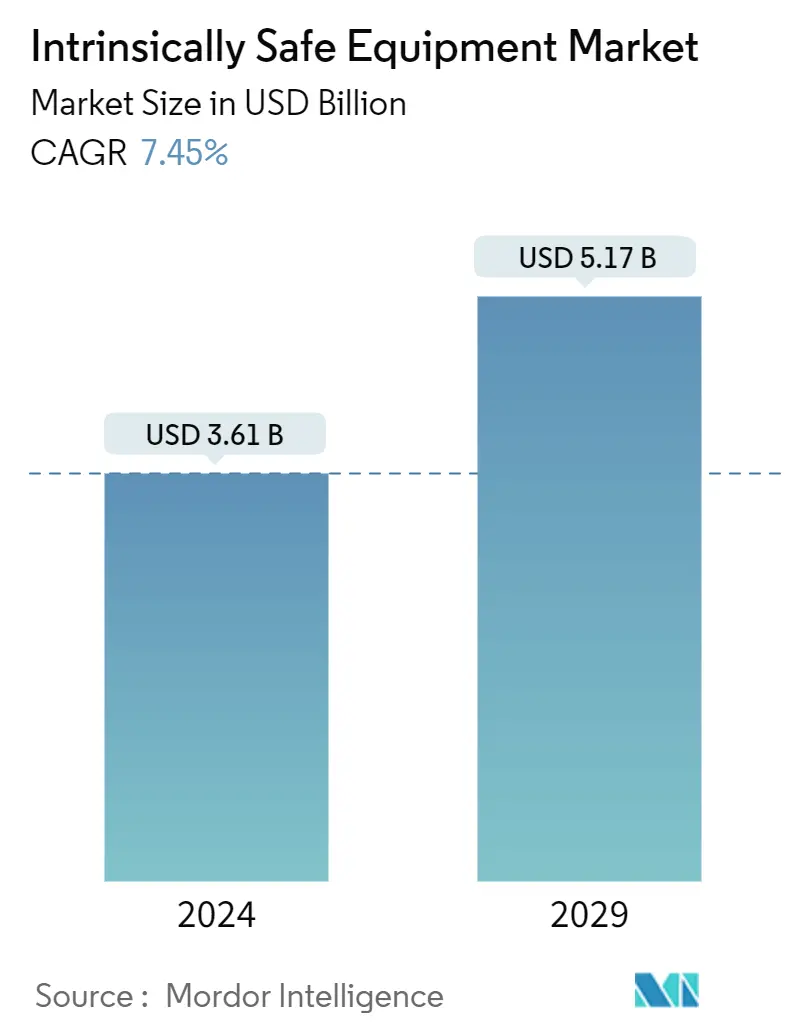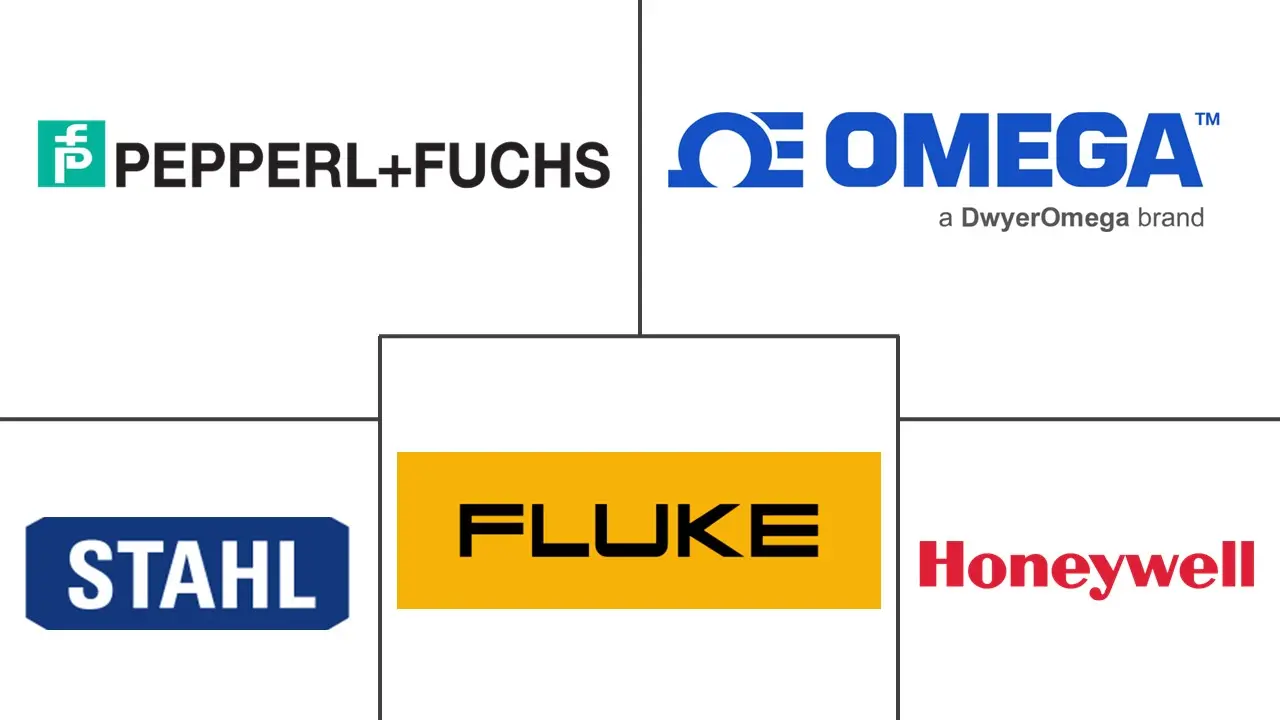Market Size of Intrinsically Safe Equipment Industry

| Study Period | 2019-2029 |
| Market Size (2024) | USD 3.61 Billion |
| Market Size (2029) | USD 5.17 Billion |
| CAGR (2024 - 2029) | 7.45 % |
| Fastest Growing Market | Asia Pacific |
| Largest Market | Asia Pacific |
Major Players
*Disclaimer: Major Players sorted in no particular order |
Intrinsically Safe Equipment Market Analysis
The Intrinsically Safe Equipment Market size is estimated at USD 3.61 billion in 2024, and is expected to reach USD 5.17 billion by 2029, growing at a CAGR of 7.45% during the forecast period (2024-2029).
Intrinsically safe equipment is equipment and wiring that cannot release sufficient electrical or thermal energy under normal or abnormal conditions to cause the ignition of a specific hazardous atmospheric mixture in its most easily ignited concentration. This is achieved by limiting the amount of power available to the electrical equipment in the dangerous area to a level below that which will ignite the gases. Fuel, oxygen, and an ignition source must be present to have a fire or explosion.
An intrinsically safe system assumes that fuel and oxygen are present in the atmosphere. Still, the system is designed in a way that the electrical energy or thermal energy of a particular instrument loop can never be significant enough to cause ignition. Intrinsic safety (IS) is an approach to the design of equipment going into hazardous areas. The idea is to reduce the available energy to a level too low to cause ignition. That means preventing sparks and keeping temperatures down.
- Flourishing industrialization is a significant factor driving the growth of intrinsically safe equipment. With the growing population, the outlook for process manufacturing is generally positive over the next year or so. According to United Nations Industrial Organizations, industrial economies ticked from a limited 2.5% Y-o-Y increase in the second quarter of 2022 to a 3.6% expansion in the third quarter. Other industrializing economies registered a Y-o-Y output increase of 4.9% in the third quarter of 2022, higher than the group of industrial economies.
- The rising oil and gas exploration activities have positively impacted the growth of the market studied, as intrinsically safe equipment is widely used in the oil and gas industry because of the highly explosive atmosphere and flammable gasses. The industry is highly prone to risks, and emergency management systems are crucial. The International Energy Agency forecasts global upstream oil and gas investments to increase by about 11% to USD 528 billion in 2023, the highest level since 2015. The renewed appetite for oil and gas reserves and production – among European majors in particular – comes after Shell and BP slowed down plans to shift away from their legacy business and invest in renewables as part of the energy transition.
- Thus, the demand for intrinsically safe equipment is expected to increase during the forecast period because of the increased safety standards for hazardous areas. The oil and gas segment held over a 30.91% share in the intrinsically safe equipment market in 2022. The oil and gas industry broadly includes areas that are hazardous to the employees and the equipment used. Moreover, the oil and gas industry includes trunk pipelines, pumping and compressor stations, and other facilities requiring modern and reliable control and safety systems.
- Occupational health and safety (OHS) regulations are essential for protecting the health and safety of workers in any industry. However, these regulations can vary significantly from region to region, including North America, Europe, Asia, Australia, and New Zealand. Thus, complying with regulations in different countries can be challenging for companies, especially those that operate across borders. One significant challenge is the cultural differences that may affect how laws are interpreted or implemented.
- Furthermore, multinational companies working in global regions have to work toward customizing their products per the varying country requirements, making their production process more complex and minimizing the rate of economies of scale. On the contrary, some of the joint international standards set by organizations such as the International Electrotechnical Commission reduce the impact of this restraint in the global market.
- The conflict between Russia and Ukraine has dramatically affected the global economy. Countries that rely on importing oil and natural gas have been particularly impacted due to their dependence on energy imports. The ongoing conflict in Ukraine could potentially result in a surge in the demand for oil and gas from African nations, as they possess the necessary reserves and infrastructure to meet this growing need. Various countries, including Japan, EU nations, and others, actively invest in Africa's oil and gas sector to reduce their reliance on Russia. Furthermore, Africans and Europeans have already begun collaborating on oil and gas projects, which are expected to further enhance the market's opportunities.
Intrinsically Safe Equipment Industry Segmentation
Intrinsically safe equipment is defined as "equipment and wiring which are incapable of releasing sufficient electrical or thermal energy under normal or abnormal conditions to cause ignition of a specific hazardous atmospheric mixture in its most easily ignited concentration." This is achieved by limiting the amount of power available to the electrical equipment in the hazardous area to a level below that which will ignite the gases.
The study tracks the revenue accrued through the sale of video telematics by various players in the global market. The study also tracks the key market parameters, underlying growth influencers, and major vendors operating in the industry that support the market estimations and growth rates over the forecast period. The study further analyses the overall impact of COVID-19 aftereffects and other macroeconomic factors on the market. The report’s scope encompasses market sizing and forecasts for the various market segments.
The intrinsically safe equipment market is segmented by zone (zone 0, zone 20, zone1, zone 21, zone 2, and zone 22), class (class 1, class 2, and class 3), products (sensors, detectors, switches, transmitters, isolators, LED indicators, and other products), end-user industry (oil and gas, mining, power, chemical and petrochemical, processing, and other end-user industries), and geography (North America [United States and Canada], Europe [Germany, United Kingdom, France, and Rest of Europe], Asia-Pacific [China, Japan, India, and Rest of Asia-Pacific], Latin America [Brazil, Mexico, Argentina, and Rest of Latin America], Middle East & Africa [Saudi Arabia, United Arab Emirates, and Rest of Middle East & Africa]). The market sizes and forecasts are provided in terms of value (USD) for all the above segments.
| By Zone | |
| Zone 0 | |
| Zone 20 | |
| Zone 1 | |
| Zone 21 | |
| Zone 2 | |
| Zone 22 |
| By Class | |
| Class 1 | |
| Class 2 | |
| Class 3 |
| By Products | |
| Sensors | |
| Detectors | |
| Switches | |
| Transmitters | |
| Isolators | |
| LED Indicators | |
| Others Products |
| By End User | |
| Oil and Gas | |
| Mining | |
| Power | |
| Chemical and Petrochemical | |
| Processing | |
| Other End Users |
| By Geography | ||||||
| ||||||
| ||||||
| ||||||
| ||||||
|
Intrinsically Safe Equipment Market Size Summary
The intrinsically safe equipment market is poised for significant growth, driven by the increasing need for safety in hazardous environments, particularly in the oil and gas sector. This equipment is designed to prevent ignition in explosive atmospheres by limiting electrical and thermal energy, making it essential for industries where flammable gases and materials are present. The market is experiencing a positive outlook due to flourishing industrialization and rising oil and gas exploration activities, which necessitate stringent safety standards. The demand for intrinsically safe equipment is further bolstered by the need for compliance with occupational health and safety regulations, which vary across regions, adding complexity to multinational operations. The ongoing geopolitical tensions, such as the conflict between Russia and Ukraine, are also influencing market dynamics by shifting energy demands and investments towards regions like Africa, thereby creating new opportunities for market expansion.
In the Asia-Pacific region, countries like China, Japan, and India are witnessing a surge in demand for intrinsically safe equipment due to increased industrial activities and stringent safety regulations. The market is characterized by a fragmented landscape with key players such as Pepperl + Fuchs, Fluke Corporation, OMEGA Engineering, R. Stahl AG, and Honeywell International Inc. actively engaging in strategic partnerships and product innovations to maintain a competitive edge. These companies are enhancing their offerings to meet the growing safety concerns and regulatory requirements across various industries, including mining, chemicals, and process manufacturing. The adoption of advanced technologies, such as machine learning for predictive maintenance, is also shaping the market's future, as seen in recent developments by companies like Amazon Inc. and Red Sky Lighting. As the global demand for energy continues to rise, the intrinsically safe equipment market is expected to expand, prioritizing safety and compliance in hazardous work environments.
Intrinsically Safe Equipment Market Size - Table of Contents
-
1. MARKET INSIGHTS
-
1.1 Market Overview
-
1.2 Industry Attractiveness - Porter's Five Forces Analysis
-
1.2.1 Threat of New Entrants
-
1.2.2 Bargaining Power of Buyers
-
1.2.3 Bargaining Power of Suppliers
-
1.2.4 Threat of Substitute Products
-
1.2.5 Intensity of Competitive Rivalry
-
-
1.3 Industry Value Chain Analysis
-
1.4 Impact of COVID-19 Aftereffects and Other Macroeconomic Factors on the Market
-
-
2. MARKET SEGMENTATION
-
2.1 By Zone
-
2.1.1 Zone 0
-
2.1.2 Zone 20
-
2.1.3 Zone 1
-
2.1.4 Zone 21
-
2.1.5 Zone 2
-
2.1.6 Zone 22
-
-
2.2 By Class
-
2.2.1 Class 1
-
2.2.2 Class 2
-
2.2.3 Class 3
-
-
2.3 By Products
-
2.3.1 Sensors
-
2.3.2 Detectors
-
2.3.3 Switches
-
2.3.4 Transmitters
-
2.3.5 Isolators
-
2.3.6 LED Indicators
-
2.3.7 Others Products
-
-
2.4 By End User
-
2.4.1 Oil and Gas
-
2.4.2 Mining
-
2.4.3 Power
-
2.4.4 Chemical and Petrochemical
-
2.4.5 Processing
-
2.4.6 Other End Users
-
-
2.5 By Geography
-
2.5.1 North America
-
2.5.1.1 United States
-
2.5.1.2 Canada
-
-
2.5.2 Europe
-
2.5.2.1 Germany
-
2.5.2.2 United Kingdom
-
2.5.2.3 France
-
2.5.2.4 Rest of Europe
-
-
2.5.3 Asia-Pacific
-
2.5.3.1 China
-
2.5.3.2 Japan
-
2.5.3.3 India
-
2.5.3.4 Rest of Asia-Pacific
-
-
2.5.4 Latin America
-
2.5.4.1 Brazil
-
2.5.4.2 Mexico
-
2.5.4.3 Argentina
-
2.5.4.4 Rest of Latin America
-
-
2.5.5 Middle East & Africa
-
2.5.5.1 Saudi Arabia
-
2.5.5.2 United Arab Emirates
-
2.5.5.3 Rest of Middle East & Africa
-
-
-
Intrinsically Safe Equipment Market Size FAQs
How big is the Intrinsically Safe Equipment Market?
The Intrinsically Safe Equipment Market size is expected to reach USD 3.61 billion in 2024 and grow at a CAGR of 7.45% to reach USD 5.17 billion by 2029.
What is the current Intrinsically Safe Equipment Market size?
In 2024, the Intrinsically Safe Equipment Market size is expected to reach USD 3.61 billion.

